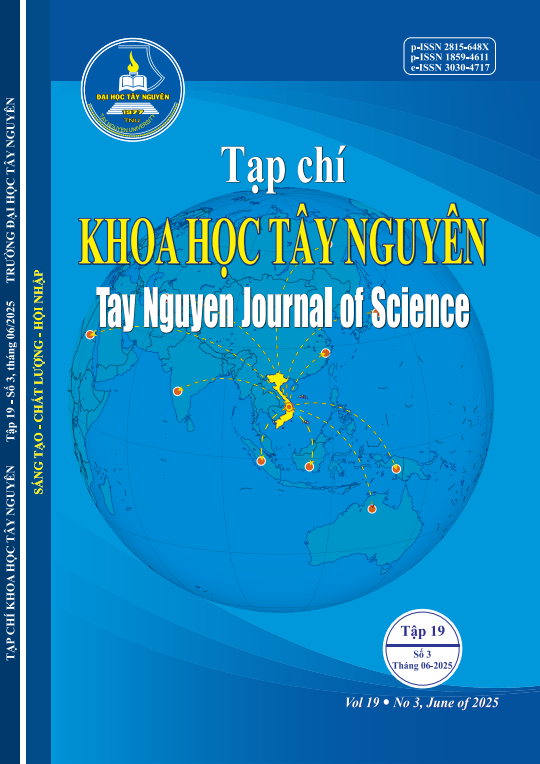Đau vùng thắt lưng chậu trong thai kỳ - tỷ lệ mắc bệnh và các yếu tố liên quan
Main Article Content
Đau vùng thắt lưng chậu trong thai kỳ - tỷ lệ mắc bệnh và các yếu tố liên quan
Tóm tắt
Đau vùng thắt lưng chậu trong thai kỳ là vấn đề sức khỏe phổ biến, ảnh hưởng đến chất lượng cuộc sống của nhiều thai phụ. Đây là một nghiên cứu mô tả cắt ngang được thực hiện trên 385 thai phụ đủ tháng đến khám tại Bệnh viện Đại học Tây Nguyên (01/2023 - 6/2023) nhằm khảo sát tỷ lệ, mức độ ảnh hưởng và các yếu tố liên quan đến bệnh lý này. Kết quả: Tỉ lệ mắc đau vùng thắt lưng chậu được ghi nhận là 76,9%. Trong đó, đau thắt lưng chiếm 43,6%, đau vùng chậu 12,8%, và thể kết hợp 43,6%. Đau khởi phát chủ yếu trong 3 tháng cuối thai kỳ (61,5%). Mức độ đau từ nhẹ đến trung bình (VAS ≤ 6 điểm) chiếm 77%, trong khi mức độ nặng và rất nặng (VAS >7) chiếm 23%. Đánh giá qua thang ODI, đau vùng thắt lưng chậu làm giảm chức năng tối thiểu ở 26,7%, trung bình 53,4%, nặng 19,6%, và tàn phế 0,3%. Độ tuổi ≥35 và BMI trước sinh ≥25 làm tăng nguy cơ mắc bệnh (p<0,05). Người Êđê có nguy cơ mắc bệnh thấp hơn 0,56 lần so với người Kinh (p<0,05, OR: 0,56 (0,35-0,89)). Tiền sử đau trước mang thai và trong lần mang thai trước làm tăng nguy cơ tái phát lần lượt 4,8 lần (OR= 4,8 (2,39-9,67)) và 3,4 lần (OR= 3,4 (1,87-6,29)).
Article Details

Tác phẩm này được cấp phép theo Giấy phép quốc tế Creative Commons Attribution-NonCommercial-NoDeri Phái sinh 4.0 .
Tài liệu tham khảo
- Bryndal, A., Majchrzycki, M., Grochulska, A., Glowinski, S. & Seremak-Mrozikiewicz, A. (2020). Risk Factors Associated with Low Back Pain among A Group of 1510 Pregnant Women. Journal of personalized medicine. 10(2).
- Carlsson, AM. (1983). Assessment of chronic pain. I. Aspects of the reliability and validity of the visual analogue scale. Pain. 16(1):87-101.
- Daneau, C., Abboud, J., Marchand, A.A., Houle, M., Pasquier, M., Ruchat, S.M., et al.(2021) Mechanisms Underlying Lumbopelvic Pain During Pregnancy: A Proposed Model. Front Pain Res (Lausanne). 2:773988.
- Fairbank, J.C. & Pynsent, P.B. (2000). The Oswestry Disability Index. Spine. 25(22):2940-52; discussion 52.
- Haugland, K.S., Rasmussen, S. & Daltveit, A.K. (2006). Group intervention for women with pelvic girdle pain in pregnancy. A randomized controlled trial. Acta Obstet Gynecol Scand. 85(11):1320-6.
- Kanakaris, N.K., Roberts, C.S. & Giannoudis, P.V. (2011). Pregnancy-related pelvic girdle pain: an update. BMC medicine. 9:15.
- Kalinowski, P. & Krawulska, A. (2017). Kinesio Taping vs. Placebo in Reducing Pregnancy-Related Low Back Pain: A Cross-Over Study. Medical science monitor : international medical journal of experimental and clinical research. 23:6114-20.
- Kovacs, F.M., Garcia, E., Royuela, A., González, L. & Abraira, V. (2012). Prevalence and factors associated with low back pain and pelvic girdle pain during pregnancy: a multicenter study conducted in the Spanish National Health Service. Spine. 37(17):1516-33.
- Larsen, E.C., Wilken-Jensen, C., Hansen, A., Jensen, D.V., Johansen, S. & Minck. H. et al.(1999) Symptom-giving pelvic girdle relaxation in pregnancy. I: Prevalence and risk factors. Acta Obstet Gynecol Scand. 78(2):105-10.
- Mens, J.M., Vleeming, A., Stoeckart, R., Stam, H.J. & Snijders, C.J. (1996). Understanding peripartum pelvic pain. Implications of a patient survey. Spine. 21(11):1363-9; discussion 9-70.
- Moore Simas, T.A., Waring, M.E., Sullivan, G.M., Liao, X., Rosal, M.C., Hardy, J.R., et al. (2013). Institute of medicine 2009 gestational weight gain guideline knowledge: survey of obstetrics/ gynecology and family medicine residents of the United States. Birth (Berkeley, Calif). 40(4):237-46.
- Malmqvist, S., Kjaermann, I., Andersen, K., Økland, I., Brønnick, K. & Larsen, J.P. (2012). Prevalence of low back and pelvic pain during pregnancy in a Norwegian population. J Manipulative Physiol Ther. 35(4):272-8.
- Ostgaard, H.C., Zetherström, G. & Roos-Hansson, E. (1994). The posterior pelvic pain provocation test in pregnant women. European spine journal : official publication of the European Spine Society, the European Spinal Deformity Society, and the European Section of the Cervical Spine Research Society. 3(5):258-60.
- Perkins, J., Hammer, R.L., Loubert, P.V. (1998). Identification and management of pregnancy-related low back pain. J Nurse Midwifery. 43(5):331-40.
- Stuge, B., Hilde, G., Vøllestad, N. (2003). Physical therapy for pregnancy-related low back and pelvic pain: a systematic review. Acta Obstet Gynecol Scand. 82(11):983-90.
- To, W.W. & Wong, M.W. (2003). Factors associated with back pain symptoms in pregnancy and the persistence of pain 2 years after pregnancy. Acta obstetricia et gynecologica Scandinavica. 82(12):1086-91.
- Vleeming, A., Albert, H.B., Ostgaard, H.C., Sturesson, B. & Stuge, B. (2008). European guidelines for the diagnosis and treatment of pelvic girdle pain. European spine journal : official publication of the European Spine Society, the European Spinal Deformity Society, and the European Section of the Cervical Spine Research Society. 17(6):794-819.
- Wang, S.M., Dezinno, P., Maranets, I., Berman, M.R., Caldwell-Andrews, A.A. & Kain, Z.N. (2004). Low back pain during pregnancy: prevalence, risk factors, and outcomes. Obstet Gynecol. 104(1):65- 70.



